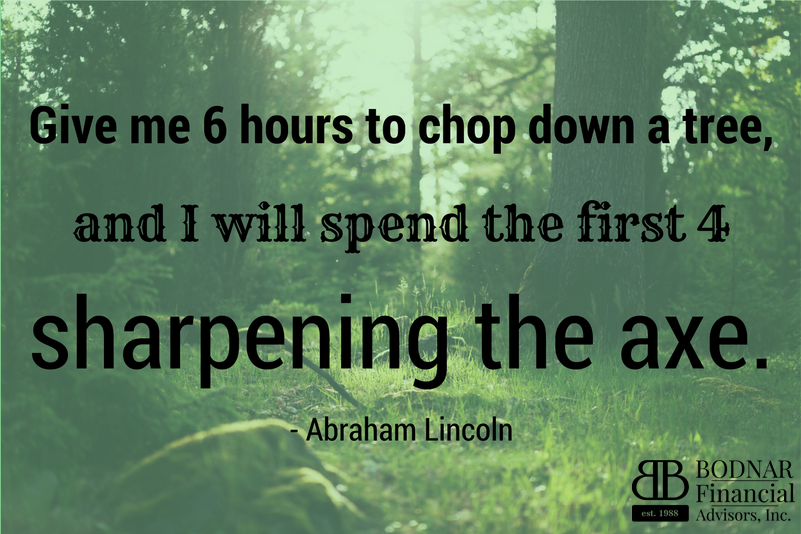12 Steps to Getting Organized With Your Money in 2017

The hardest part about taking control of your finances is getting started.
After weeks of untangling twinkle lights, entertaining relatives (who all seem to have developed new food allergies since last year), and fighting for parking spots at the mall, nobody has the energy -mental or physical- to blow the dust off the good ol’ family budget book.
It makes you want to finish off the egg nog just thinking about it, doesn’t it?
While you’re pouring, consider something Abraham Lincoln once said:
When it comes to achieving your financial goals in 2017, preparation is EVERYTHING.
Below is a quick 12-step guide to getting organized with your money without having a nervous breakdown. With a little organization and initiative (no vision boards, I promise), we can get through this.
STEP 1: Stop beating yourself up about money.
Out of all the people who set financial New Year’s resolutions in 2016, only half of them achieved 80% or more of their goal. If personal finance were easy, Americans wouldn’t be averaging over $16,000 in household credit card debt.
If you are reading this, you’ve already taken the biggest step towards long-term financial security: caring in the first place.
STEP 2: Calculate your net worth.
The best place to start is by filling out a balance sheet, the financial scorecard that calculates your net worth. It’s exactly what it sounds like: a spreadsheet that lists all your assets, all your debt, and totals them up to determine if you’re in the red or the black.
If you find yourself in the red, don’t panic! In the age of student loans, having a negative net worth is a lot more common than you’d think. The only way to improve your financial health is to take an honest snapshot of your current situation. If you are ready to quit already, take a hot minute and revisit STEP #1. We’ll wait.
STEP 3: Set some life goals.
Money doesn’t exist in a vacuum, it’s a tool to help people achieve their life goals. What do you want to be when you grow up someday? Whether you want to buy a house and raise 5 kids, or backpack across the world and become a travel writer, it’s going to take a financial plan.
PS: It’s never too late to set personal goals. I have some new clients who are 60+ years old, and my first question remains the same, “What do you want to be when you grow up someday?” The answer isn’t always a job. Think outside of the box: is your dream to retire in a beach house? Or to sit on the board of your favorite charity? Maybe you want to give your kids a student loan-free education someday.
Defining your personal goals is the first step in creating a short and long-term financial strategy.
STEP 4: Check your credit score and report.
Let’s just rip this Band-Aid off right away. Your credit score is what lenders look at before they decide whether or not to front you some money. Having a bad credit score can hurt your chances at buying a house someday, opening a new credit card, getting a decent insurance policy, or even landing a job. It’s also not a bad idea to scan your credit report for suspicious activity that could indicate identity theft.
There are 3 major credit bureaus: TransUnion, Equifax and Experian. Credit scores can range from 300-850 (which is kind of a weird scale, but we all roll with it). The higher the score, the better. You can check all 3 of your credit scores for free every year at www.annualcreditreport.com.
STEP 5: Be strategic about your debt management plan.
Lenders don’t offer minimum payments as a courtesy. Paying the bare minimum leaves you paying more interest in the long-term. Like, a LOT more.
Make sure you are structuring your debt plan to pay off principal (aka. the actual amount of debt you owe), not just the interest. Start by making a list of your debts and their interest rates. General rule of thumb: whichever one has the highest interest rate, pay that off first.
Like most things in life, there are always exceptions to the rule- this is where a financial advisor comes in. A Certified Financial Planner® can help you determine what debt management strategy works best for your specific situation.
(How to Choose a Financial Planner: 5 Things That Actually Matter)
STEP 6: Make a budget realistic to your life goals.
We’ve been avoiding the “b” word, but it’s time. Once you have a better sense of what you’re planning for, it’s time to sit down and create a BUDGET.
Start with a list of recurring income and expenses (ie. any bills you pay on a yearly, quarterly, or monthly basis). Check your credit card statements for gas and grocery bills to figure out their average monthly costs. If you are feeling ambitious, include holiday shopping and vacations as annual recurring expenses so they don’t sneak up on you.
Don’t forget to include a cash cushion for one-time costs like wedding presents (and travel), medical bills, or the “accidental” 2am online shopping order.
STEP 7: Switch your paycheck to direct deposit, and set bills to auto-pay.
Auto-billing prevents you from accidentally missing payments, and allows you the opportunity to rack up credit card rewards points in the process. If you dread the idea of having multiple online billing accounts, consider a password manager like RoboForm or LastPass to make sure you never get locked out.
STEP 8: Open a high-yield savings account.
Are you tired of working your butt off to save money, only to have the bank award your sacrifice with a measly .10% interest? Online-only banks like Bank of Internet USA (BoFi) provide FDIC-insured deposit accounts with interest rates as high as 1%.
Think dollars of interest each month, rather than pennies. If you are primarily using online and mobile banking anyway, a BoFi account is a great opportunity to start collecting serious interest on your savings.
(Bodnar Financial negotiated a special interest rate with BOFI advisor. Access the instructions to open a new account here.)
STEP 9: Increase your retirement and college savings contributions.
If your employer offers a 401k contribution match, you should at LEAST be paying the maximum match into your plan. If you can spare it (and most people can), slightly increase your contribution rate this year. Even if it’s only by a few percentage points.
Here’s why:
When it comes to retirement planning and college savings, time is your best friend. The earlier you can start saving the better, thanks to compound interest: the magical force within the financial universe that accumulates “interest on your interest.” In other words, putting away $100 a year for 10 years will have a much larger return than simply having $1000, 10 years from now.
Whether it’s a 401k, IRA, college savings plan, or Roth IRA, become friends with compound interest. You will be shocked at the difference it makes.
(SavingForCollege.com has an awesome “Price of Procrastination Calculator” which demonstrates exactly this point.)
STEP 10: Update your estate plan, especially your beneficiary information.
Estate planning protects your loved ones in the event something ever happened to you. If you don’t write up a will or establish a trust (or both), the biggest beneficiary of your life’s work might be the government.
Making sure you update the beneficiary information on retirement plans is just as important (if not more) as creating a will or trust. The beneficiary arrangements on life insurance and retirement plans actually overrule the wishes laid out in a written will.
Just to recap: if you don’t have an estate plan, your money could go to the government. If you have an outdated estate plan, your money could go to your ex-husband. (I’ll let you decide which one is worse.)
While you’re accessing any IRA retirement plans, Roth IRAs, single-k plans, or beneficiary IRAs for your balance sheet, protect your legacy and make sure the beneficiary information is accurate.
STEP 11: Revisit your insurance policy.
If you are planning to start a new business, start a family, make a major purchase, or retire comfortably, you need to manage your risks. Some risks you can self-insure, but others require co-managing the risk with an insurance company.
Being properly insured is the responsible thing to do (I believe kids these days call this “adulting”), but buyer beware: don’t let insurance companies talk you into paying for more insurance coverage than you need.
A financial advisor can help match you with insurance coverage that best meets your individual needs and lifestyle, including: disability, life, long-term care, health, medical savings accounts, auto, business, homeowners, excess liability (umbrella) and more.
STEP 12: Meet Annually with a Certified Financial Planner (CFP®)
A lot of people believe you need to be a millionaire to have a financial planner- that could not be farther from the truth. Have you ever thought to yourself: “I know there are things I should be doing to save money and plan for retirement, but I just don’t have the time to start looking these things up”?
Society doesn’t expect you to be an expert on politics, fitness, cars, home repair, or the like. Why should you have to be an expert on debt reduction, insurance, or cash flow analysis?
A Certified Financial Planner® can start at square one to help you determine your unique financial goals, develop a spending budget, calculate your net worth and retirement number, identify your risk tolerance, and maybe even help you find money from a 401(k) you forgot about years ago.
(Yes, the CFP® designation matters. See why here.)
So, those are my 12-steps to getting serious about your money in 2017. Don’t even know where to begin?
Bodnar Financial Advisors, Inc. has been helping individuals and families achieve their life goals with a sense of security since 1988.
Life is too short to worry about money and your financial future. Let our team at Bodnar Financial do the grunt work and the heavy lifting for you.



